Discovering Al Shindagha Museum: Dubai's Cultural Gem
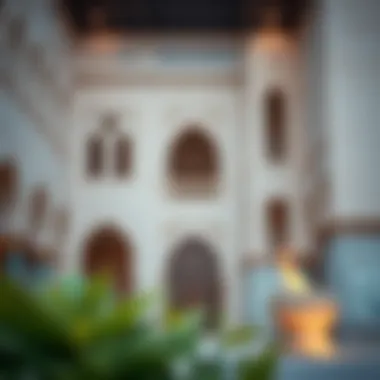
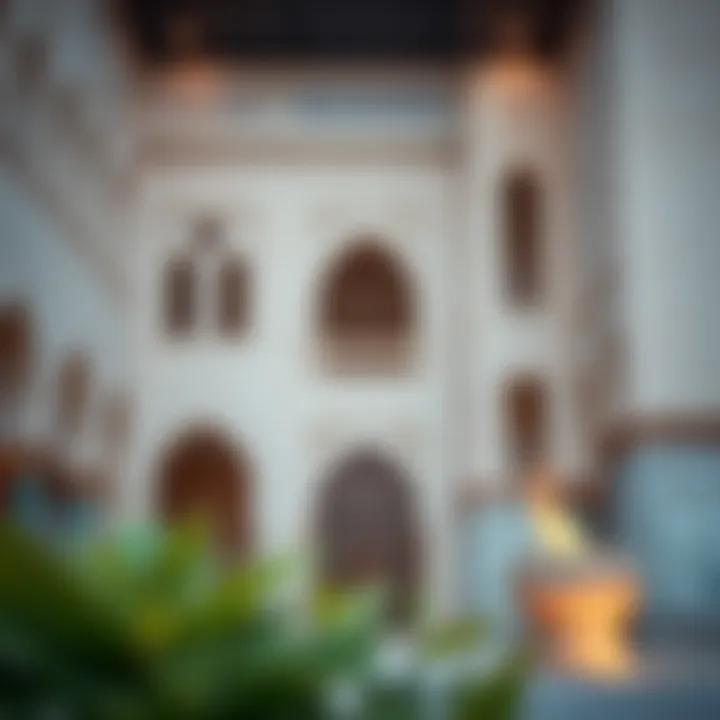
Intro
Al Shindagha Museum stands as a testament to the Middle Eastern journey through time, particularly focusing on Dubai’s transformation from a humble fishing village into a vibrant global metropolis. This museum is not merely a building filled with artifacts; it is a living library that breathes the essence of local culture and history. As we explore the nuances of this cultural landmark, the significance it holds within the broader vision of Dubai and its evolution becomes crystal clear.
The museum encapsulates various themes, such as traditional crafts, maritime history, and the influence of trade on Dubai’s development. Through engaging exhibitions, visitors are offered rich narratives—each telling a piece of the story that forms the city’s unique identity. Let’s dive deeper into what the museum offers, not only in terms of cultural value but also its potential in enhancing tourism and local investments.
Overview of Al Shindagha Museum
Al Shindagha Museum stands as a vital touchstone for understanding Dubai’s rich tapestry of culture and history. Set against the backdrop of the historic Al Shindagha district, the museum is not just a space for exhibitions. It is a living chronicle that encapsulates the essence of the emirate's evolution from a modest fishing village into a global metropolis.
With its wide array of displays that cover everything from traditional craftwork to narratives about the city’s development through trade and exploration, visitors aren't just observers. They get drawn into a fabric of stories, reflecting the trials and triumphs faced by Dubai’s residents through the ages. This museum became crucial for visitors keen to grasp how the past intertwines with the present in shaping the identity of this vibrant city.
Historical Context
The historical context of Al Shindagha Museum sets the tone for understanding Dubai's journey. The area itself pulses with tales from centuries ago, rooted in its role as a center for pearl diving and trade. Diplomatic ties, maritime heritage, and cultural exchanges have shaped the identity of Dubai.
The establishment of the museum pays homage to that lineage—emphasizing the importance of preserving the Emirati narrative. Exhibits standing on the foundations of old watchtowers and simple homes truly capture the spirit of what life was like back then. Traces of art, architecture, and day-to-day practices resonate with each display, layering further meaning onto simple artifacts.
On a city-wide scale, the museum's formation comes as Dubai embraces its heritage amidst rapid modernization. As a result, visitors unearth more than just history; they experience a sense of connection to a culture that is fast being defined by its forward-looking ambitions, yet remains deeply anchored in its past.
Purpose and Mission
The purpose and mission of Al Shindagha Museum are clear: to serve as a beacon of cultural education and preservation. This isn't merely about showing off traditional items; it’s about creating an environment where the public engages with history actively. By providing a platform for discussions, workshops, and educational programs, the museum strives to ignite curiosity and foster respect for the rich history of Dubai.
In promoting the understanding of local culture, the museum also opens doors for community members and tourists alike to interact. It emphasizes the need for dialogue around cultural heritage in a place that is increasingly becoming a melting pot of nationalities and traditions. The initiative helps create a unified identity that appreciates both the old and the new, encouraging inclusivity in a city that celebrates diversity.
Ultimately, Al Shindagha Museum aims to inspire visitors not only to appreciate the past but also to reflect on their own roles in the ongoing story of Dubai. The museum fosters a sense of belonging and pride that resonates far beyond its walls.
Architectural Design
The architectural design of Al Shindagha Museum plays a crucial role in how the heritage and culture of Dubai are conveyed to its visitors. The blend of traditional and modern elements not only enhances the aesthetic appeal but also communicates a deeper narrative about the city's evolution. This duality reflects a broader trend in urban development, where the past and the present coexist, attracting a diverse audience, including investors, brokers, and expatriates eager to understand Dubai’s unique identity.
Traditional Emirati Architecture
At the heart of the museum's aesthetic is the embodiment of traditional Emirati architecture. The structures are characterized by wind towers, known locally as barjeel, which serve as natural cooling systems. These ingenious designs harness wind currents, keeping interiors comfortable even in Dubai's sweltering heat. By committing to these architectural features, the museum not only preserves the essence of Emirati heritage but also educates visitors about sustainable practices that have thrived for centuries before modern technology.
Moreover, the use of materials such as coral stone and mud bricks is prevalent in the museum's construction. Such choices reflect the local resources available in the region, connecting the buildings to the landscape itself. This traditional aesthetic, with its intricate carvings and muted earth tones, offers a stark contrast to the towering glass skyscrapers that now dominate Dubai's skyline, reminding visitors of the city’s humble beginnings.
Integration of Modern Elements
While the roots of the architecture are deep in tradition, the Al Shindagha Museum does not shy away from modernity. The careful integration of contemporary design elements creates an inviting atmosphere that resonates with today’s visitor. Large glass panels, for example, allow natural light to flood the exhibition spaces, creating an engaging environment that enhances the experience of the artworks and artifacts on display.
The synergy between old and new is not just visual; it serves a functional purpose as well. For instance, the incorporation of technology enhances interactive exhibits, making history more accessible. Visitors can engage with touch screens to learn about the context behind each artifact or experience virtual tours that delve deeper into Dubai’s history. This blend not only captivates tech-savvy audiences but also ensures that the museum meets the expectations of a modern world while still honoring its past.
Exhibitions and Collections
The exhibitions and collections at Al Shindagha Museum are a testament to Dubai’s vibrant culture and history. They play a critical role in connecting visitors with the past, allowing them to explore the threads of tradition that have woven the fabric of this unique city. Through these displays, the museum not only highlights significant artifacts but also creates an immersive experience that underscores the importance of preserving cultural identity.
Permanent Exhibitions
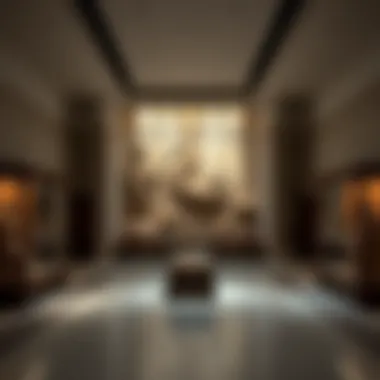
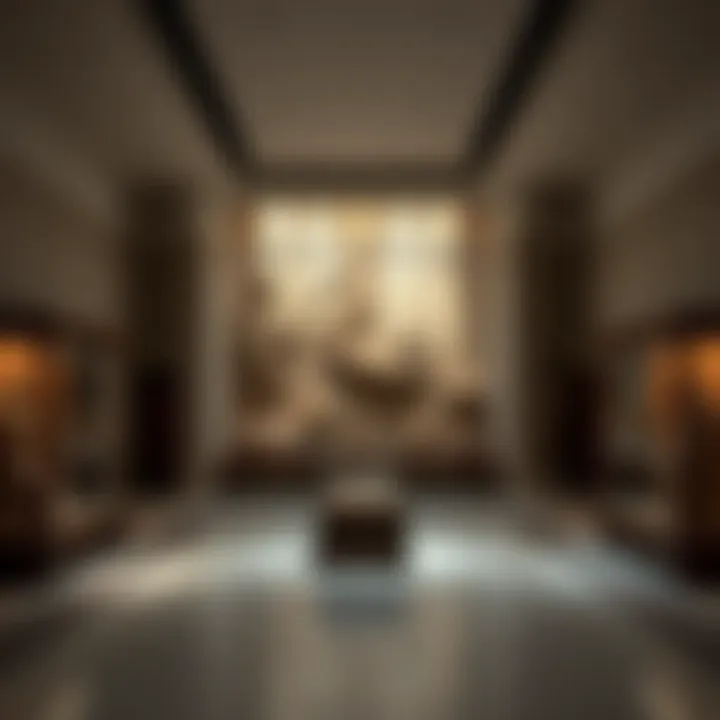
The permanent exhibitions at the Al Shindagha Museum are like time capsules, encapsulating the essence of Dubai's heritage. Each one is carefully curated to showcase various aspects of life in the Emirate, from the ancient pearl diving industry to traditional Emirati customs and crafts. Visitors can admire intricate artifacts such as vintage fishing gear, ancient coins, and beautifully crafted pottery.
These exhibitions serve a dual purpose; they educate the public while preserving the stories of the past. Visitors are often amazed at how much the everyday lives of Emiratis have changed over the decades, and these permanent collections serve as a reminder of those roots.
- Cultural Artifacts: Items used by the local community throughout history, including textiles, jewelry, and kitchenware.
- Historical Documentation: Photographs and documents that illustrate the transformation of Dubai, showcasing key moments, such as the discovery of oil and its effects on the city’s growth.
"The best museums are like books that can be read in a million ways, offering a new perspective with each visit."
Temporary Exhibitions
Temporary exhibitions at Al Shindagha Museum are a dynamic addition that ensures fresh narratives continually emerge. These exhibitions often focus on specific themes, commemorating significant events or collaborations with local artists and historians. Some might showcase contemporary art while others might delve into specific elements of Emirati culture, such as food, music, or dance.
What makes these exhibitions particularly intriguing is their ability to react to current trends and interests. For example, an exhibition might feature the works of local artists who blend modern techniques with traditional Emirati art forms, providing a bridge between the past and the present.
- Special Collaborations: The museum frequently partners with galleries and cultural institutions, which enhances the variety in its offerings.
- Thematic Focus: Each temporary exhibition is thoughtfully designed to provoke thought and discussion, often addressing contemporary issues facing the region, such as sustainability, identity, and globalization.
In essence, the exhibitions and collections at Al Shindagha Museum not only preserve history but also celebrate its evolution, providing a comprehensive glimpse into the life and times of Dubai.
Cultural Significance
The Al Shindagha Museum stands as a cornerstone of Dubai's cultural identity, weaving together the past and present to provide a profound understanding of the emirate’s evolution. This museum does not merely house artifacts; it serves as a bridge connecting generations, offering insights into the customs, traditions, and history that have shaped Dubai. The significance of this cultural landmark can be observed through several vital elements, particularly in its role in heritage preservation and the avenues for education and community engagement.
Preservation of Heritage
The endeavor to preserve heritage at Al Shindagha Museum reflects a broader mission to maintain Dubai's rich tapestry of history. The various artifacts and exhibitions illustrate how the city has transformed from a modest fishing and pearling community to a vibrant metropolis. For instance, displays showcasing traditional Emirati crafts not only serve to educate visitors but also to ignite a sense of pride among locals regarding their heritage.
"Preserving heritage is akin to saving history's whispers for future generations to hear."
In doing so, the museum plays a critical role in countering the rapid modernization that characterizes Dubai today. Artifacts, such as traditional fishing tools, historical photographs, and personal stories from the Emirati community vividly paint the vibrancy of local customs. The museum does not shy away from the difficult aspects of history either, addressing social changes and how they affect identity. This nuanced approach encourages visitors to reflect deeply on what it means to be part of a rapidly evolving society.
Education and Community Engagement
Education is a cornerstone of the Al Shindagha Museum’s mission. Continuously offering workshops, guided tours, and interactive exhibitions, the museum engages with both locals and tourists to foster knowledge-sharing and cultural exchange. The guided tours, often led by knowledgeable guides who share personal anecdotes tying them to the heritage, enhance the educational experience. Visitors find themselves enthralled not just by the artifacts but by the stories that give them life.
Moreover, the museum actively reaches out to schools and communities, providing tailored programs aimed at younger generations. By involving students in various cultural activities, the museum instills a sense of connection to their roots. The efforts to engage communities go beyond mere education; they are an invitation to participate in a living cultural discourse that enriches everyone involved.
Visitor Information
In visiting Al Shindagha Museum, understanding the visitor information is crucial for making the most of your experience. This section presents pertinent details that help visitors navigate their trip, ensuring that they relish all facets of the museum while maximizing convenience. The insights provided here touch on location, opening hours, and admission fees, allowing potential visitors—tourists and residents alike—to plan effectively.
Location and Accessibility
Al Shindagha Museum is nestled in the heart of Dubai's historic district, along the banks of the Dubai Creek. The address, close to other significant cultural landmarks, makes it an easily accessible destination for those exploring the city. For instance, it can be found at Al Shindagha, Bur Dubai, making it proximity-rich to other venues such as the Dubai Frame and the Museum of the Future.
When it comes to getting to the museum, there are several options:
- Public Transport: The Dubai Metro provides good accessibility, with the nearest metro station being Al Fahidi. From there, visitors can hop into taxis, which are readily available.
- Water Taxi: This unique option allows tourists to enjoy the scenic route via the creek, providing a traditional view of Dubai. Water taxis stop near the museum, offering a picturesque entrance.
- Driving: For those preferring personal vehicles or rentals, the museum is well marked and has convenient parking options available nearby.
The combination of these transport methods ensures that almost everyone can access the museum easily.
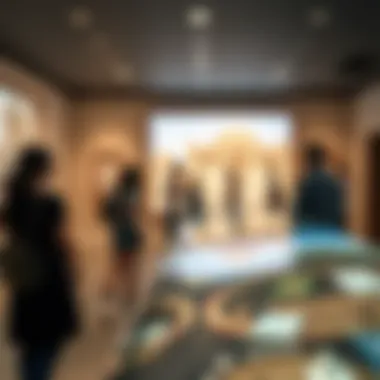
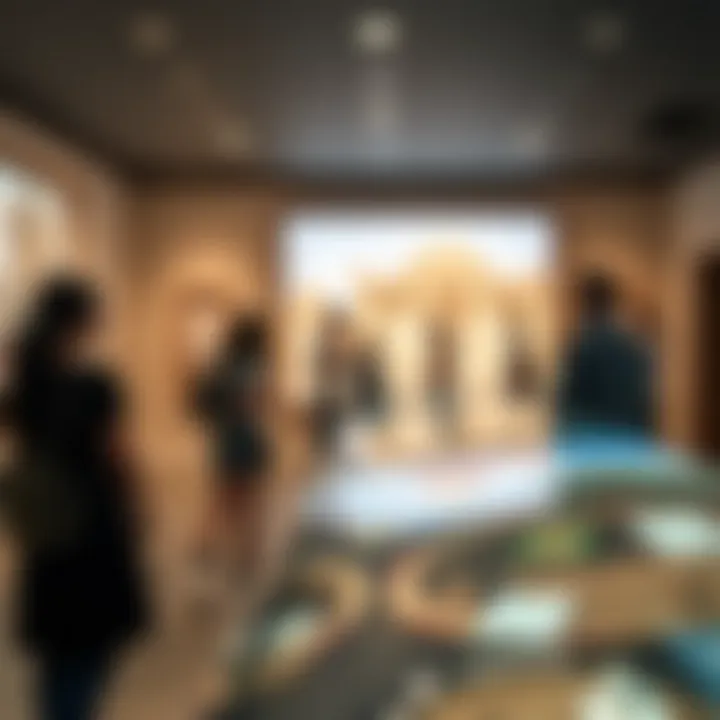
Opening Hours and Admission Fees
It’s essential to know the operating hours to plan your visit efficiently. Al Shindagha Museum has set a schedule that makes it flexible for various visitors. The museum typically operates from 10 AM to 8 PM on weekdays, with extended hours over the weekends until 10 PM. This gives families and working individuals ample time to visit, especially on Saturdays and Sundays when they might have more free time.
As for the admission fees, the museum offers an economical pricing structure:
- General Admission: AED 20, an amount that provides entry to all the permanent exhibitions, making it a worthwhile excursion for the knowledge-seeking visitor.
- Discounted Admission: For students, children under 12, and seniors, a reduced fee of AED 10 applies.
- Free Entry: Children under the age of five can enter for free, enabling families to explore together without financial strain.
This transparent pricing makes Al Shindagha Museum not only a cultural hub but also an accessible one, inviting all layers of society to engage with its offerings.
"Visiting Al Shindagha Museum isn't just an educational affair; it's an experience that resonates within Dubai's continuing journey through time."
By ensuring that potential visitors have access to practical information, the allure of Al Shindagha Museum becomes even more enticing. A well-informed visitor is an empowered visitor, ready to soak in the richness of Dubai’s heritage as told through this cultural landmark.
Al Shindagha Museum in the Context of Dubai
Role in Cultural Tourism
Al Shindagha Museum occupies a pivotal space in shaping Dubai's identity as a cultural tourism hub. Visitors not only delve into the rich tapestry of Emirati heritage but also experience firsthand the evolution of this dazzling city. With the increasing influx of tourists seeking authenticity amidst the modern skyline, the museum provides a balanced perspective that honors the past.
A walk through this museum isn't just a leisurely exploration; it's a guided journey through centuries of history. Engaging displays elicit a deeper understanding of traditional crafts, trade routes, and the societal changes that shaped Dubai. Such engagements resonate profoundly with tourists who yearn for a meaningful connection to the locales they visit. The museum's presence strengthens Dubai's narrative as a city that respects and preserves its roots while continuing to grow.
According to recent statistics, cultural tourism accounts for nearly 40% of the tourism revenue in Dubai, highlighting the importance of institutions like Al Shindagha. As it continues to unfurl its stories, the museum plays a significant role in enticing visitors. It’s a blend of education with entertainment, ensuring that everyone walks away with a piece of Dubai’s rich history etched in their memory.
Impact on Real Estate Market
The influence of Al Shindagha Museum extends beyond cultural enrichment to the very fabric of Dubai’s real estate landscape. Its presence is not merely a footnote; it significantly sways property values and encourages development around it.
Influence on Property Valuation
The museum's existence positively impacts property valuation in its surrounding areas. Properties located nearby tend to command higher prices, reflecting the desirability of the location. This phenomenon stems from the prospect of catering to a steady stream of visitors, including tourists and business professionals alike. Investors notice an uptick in interest from expatriates seeking homes that offer both cultural richness and modern conveniences.
Key characteristics that drive this valuation include accessibility, amenities, and the cultural value associated with living near such a landmark. Buyers recognize that proximity to Al Shindagha not only enhances their living experience but also serves as a smart financial investment, as properties near cultural sites often appreciate more rapidly over time.
However, this potential for appreciation isn't without its drawbacks. The influx of demand sometimes translates into rising prices that may push local residents out of the market, complicating the community’s socio-economic dynamics.
Boosting Neighborhood Development
The establishment of the Al Shindagha Museum has sparked significant neighborhood development. New restaurants, cafes, and amenities have sprouted nearby, catering to both tourists and locals. This revitalization creates a vibrant atmosphere, fostering community interactions, and economic growth. It shifts into a bustling neighborhood, breathing new life into what was once quieter areas.
A key characteristic of this development is the focus on blending traditional aspects with modern needs. While contemporary structures rise, there's a conscious effort to retain the Emirati character of the surroundings, ensuring that the essence of the culture remains intact.
Such developments can lead to an impressive symbiosis between commercial interests and cultural preservation. However, this rapid expansion can also churn up challenges. Mismanagement or an overpowering emphasis on modernization might dilute the very culture the museum aims to preserve, creating a potential disconnect for visitors and locals alike.
In summary, Al Shindagha Museum does more than showcase heritage. It stands at the crossroads of cultural tourism and real estate development, influencing urban narratives through its subtle yet substantial impacts.
Visitor Experience
The Al Shindagha Museum, more than just a place to observe artifacts, represents an immersive journey into Dubai’s storied past. For visiting investors, expatriates, and researchers, this engagement with heritage not only strengthens cultural appreciation but also enriches one’s understanding of how history shapes modern contexts. A visitor's experience here encapsulates two core components—interactive features and guided tours, both vital in transforming a casual visit into a memorable exploration.
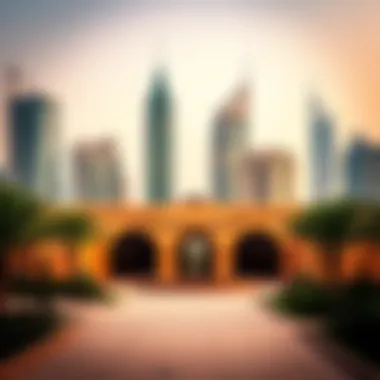

Interactive Features
When stepping into the Al Shindagha Museum, visitors are greeted with a blend of traditional displays and interactive elements that invite exploration. These features serve multiple purposes. They are designed to engage all age groups, ensuring that learning about Dubai's heritage is not just informative but also entertaining.
Some of the standout interactive installations include:
- Virtual Reality Experiences: Allows visitors to immerse themselves in historical events that shaped the city. This technology can turn a simple museum visit into a thrilling encounter with the past.
- Hands-On Exhibits: These provide the chance to touch and feel replicas of artifacts. This tactile information solidifies learning, especially for individuals who appreciate learning through doing.
- Multimedia Displays: Utilizing video and audio, these offer narratives directly from historical figures or storytellers, painting a vivid picture of Dubai's journey through time.
The interactive aspects not only cater to curiosity but forge personal connections with history, making it much more meaningful. As the museum incorporates such progressive features, it reflects a commitment to enhance visitor engagement—elevating the experience from passive observation to active participation.
Guided Tours and Workshops
Guided tours and workshops offered at the Al Shindagha Museum take the visitor experience up a notch. These are crafted with professionalism and familiarity, where guides weave captivating stories enriched with personal anecdotes and expert knowledge. Visitors find themselves not just listening, but also discussing ideas and questioning narratives—enhancing their learning experience.
Key elements of guided tours and workshops include:
- Personal Interaction: Small group sizes foster a sense of intimacy, allowing visitors to ask questions and engage freely with their guide, which is particularly valuable for expatriates wanting to learn about the history embedded in the city they now call home.
- Cultural Workshops: These workshops may cover topics such as traditional cooking, calligraphy, or poetry, encouraging visitors to delve deeper into Emirati culture. They foster a sense of communal learning and can offer networking opportunities for expatriates and investors alike.
- Customized Itineraries: For those with specific interests, the museum offers tailored experiences—be it a focus on trade history or art forms. This flexibility ensures that the experience aligns with individual preferences, making every visit unique.
Overall, engaging with the knowledgeable staff during tours and participating in workshops creates a dialogue that benefits visitors greatly. It’s more than just observing; it’s about connection and understanding, vital for anyone looking to grasp the nuances of Dubai's heritage and its implications on contemporary society.
"A visit to the Al Shindagha Museum is not just a stroll through history; it is an invitation to witness the evolution of a city through the eyes of its culture and people."
Future Developments
The landscape of Dubai is forever evolving, and Al Shindagha Museum stands at the cusp of this transformation. Discussing future developments within the museum isn’t merely about what’s next; it’s about why these changes are crucial for the preservation of culture amidst rapid urbanization. These developments will not only enhance the richness of the museum but will also have a significant impact on visitor experience and community involvement.
Expansion Plans
The expansion plans for Al Shindagha Museum are ambitious yet rooted in pragmatism. With a growing number of tourists each year, the museum seeks to provide a larger, more diverse range of exhibitions and facilities that reflect Dubai's multifaceted cultural heritage. The idea is not just to house more artifacts but to create dedicated spaces that allow visitors to immerse themselves in different aspects of Emirati history.
Plans are on the table for increased gallery space, along with interactive installations that educate on traditional crafts, local flora, and the evolution of trade routes. Moreover, additional facilities are under discussion—like cafes that offer local cuisine and areas for performing arts—that could invite families to spend the day rather than just a few hours. This would create an environment that encourages learning and appreciation of Emirati culture—an essential aspect of retaining the essence of Dubai amidst modern growth.
Enhancing Visitor Engagement
Enhancing visitor engagement is pivotal for the museum's future. The museum recognizes that merely displaying artifacts is no longer sufficient to captivate the contemporary audience. Therefore, they are considering various innovative engagement methods.
- Augmented Reality Experiences: Imagine donning a pair of AR glasses to see historical events unfold right in front of your eyes. This tech twist could add a whole new dimension to the museum experience.
- Workshops and Events: Hosting events that invite local artisans to demonstrate traditional skills can create a hands-on element to learning. Workshops on basket weaving or calligraphy could forge connections between the past and present.
- Community Collaborations: Partnerships with schools and universities for educational programs could be a game-changer. Young minds could get involved in creating exhibitions or contributing to research projects, thereby fostering a sense of ownership and pride in their heritage.
"Future developments at Al Shindagha Museum aim to create a dialogue between the past and the ever-evolving present of Dubai, ensuring that culture remains at the heart of the city’s growth."
Incorporating these strategies not only promises to enrich the visitor experience but also addresses a vital component of cultural preservation—community participation. By making the museum a focal point for both tourists and locals, Al Shindagha Museum can significantly contribute to a more informed and cohesive society.
Culmination
The exploration of Al Shindagha Museum encapsulates an essential chapter in understanding Dubai's rich cultural tapestry. This article emphasizes its multifaceted roles—not just as a museum, but as a living narrative of the emirate's history, its evolution, and its aspirations.
Summary of Key Points
- Historical Repository: The museum curates an impressive array of artifacts that showcase the transition from a modest fishing village to a bustling metropolis.
- Architectural Innovation: The blend of traditional Emirati designs with modern architectural practices signifies Dubai’s unique identity.
- Cultural Education: Exhibitions serve as a powerful means of engaging local communities and tourists alike, providing insights into the emirate's customs and social fabric.
- Tourism Booster: By attracting visitors, the museum is pivotal in enhancing Dubai's cultural tourism landscape, which, in turn, has positive effects on the local economy.
Significance in Modern Dubai
The Al Shindagha Museum is not merely a tourist attraction; it stands as a testament to how a city can honor its past while embracing the future. In the fast-paced environment of Dubai, this museum plays a crucial role in:
- Preserving Heritage: Amid rapid urbanization, the museum ensures that the essence of Emirati traditions is not lost.
- Community Engagement: By involving local schools and organizations in programs, it builds bridges between generations.
- Economic Influence: The interest stirred by the museum can contribute to an uptick in property values nearby, making it a significant player in the real estate market.







